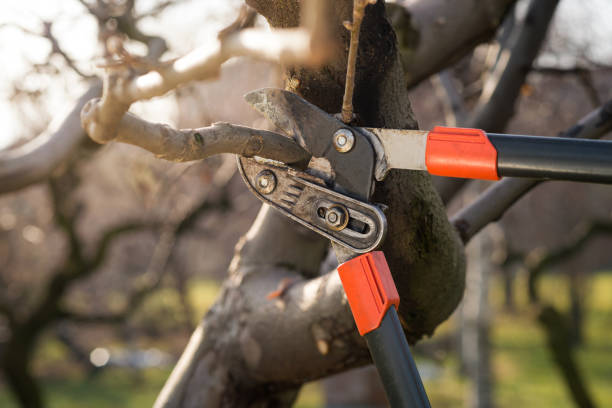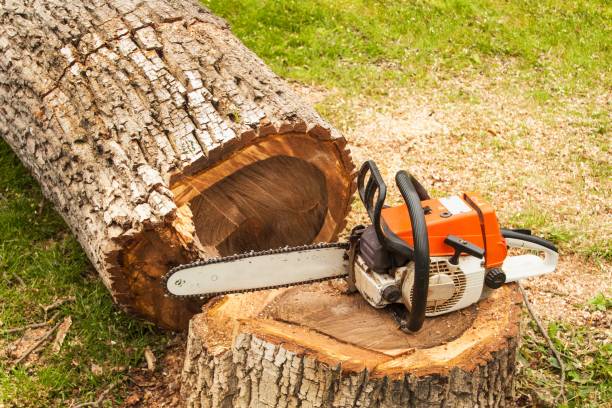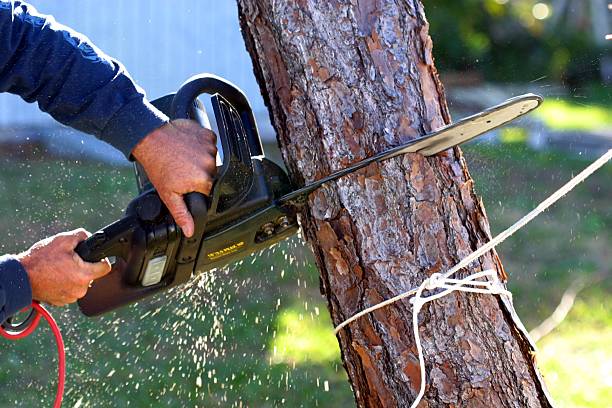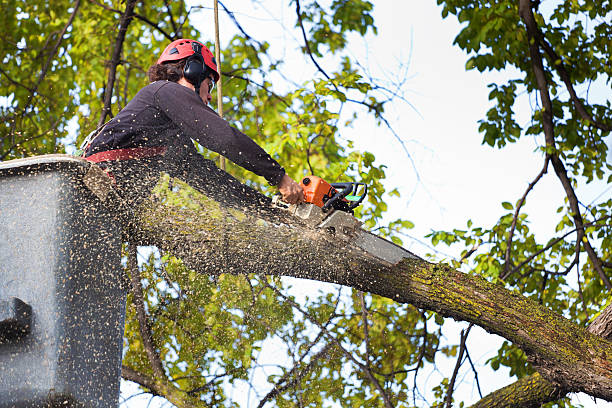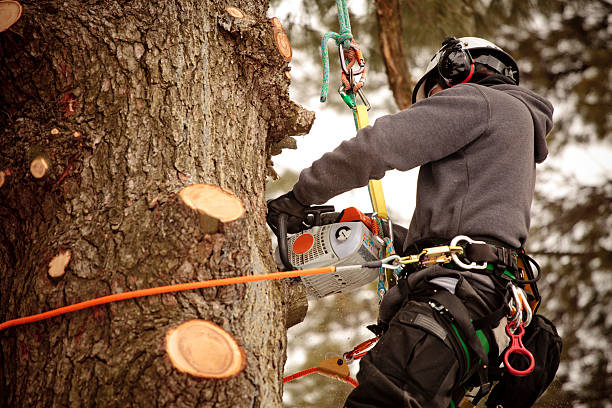
Whether you’re tackling the job yourself or hiring professionals, it’s essential to approach the process with care and proper preparation. Below, we discuss critical steps and tips for safe and effective tree stump removal.
Reasons to Remove Tree Stumps
Leaving tree stumps untreated can lead to various issues over time.
- Safety Concerns: Stumps can pose tripping hazards, especially in areas where children or pets play.
- Aesthetic Appeal: Removing a tree stump enhances the visual appeal of your yard by creating cleaner lines and more open space.
Key Considerations Before Stump Removal
- Size of the Stump: Larger stumps typically require more effort and specialized equipment for removal.
- Location: Ensure there’s enough room around the stump for tools or machinery without damaging nearby landscaping features.
- Budget Constraints: Evaluate whether a manual DIY approach is feasible or if you’ll need professional assistance.
Expert Tree Removal Company Akron OH: Effective Stump Removal Methods
- Best suited for small-to-medium-sized stumps.
- Requires basic tools like shovels, axes, saws, and a digging bar.
- Involves using commercially available stump-removal products containing potassium nitrate.
- Takes several weeks but requires minimal physical exertion.
- Utilizes specialized machinery like stump grinders for quick results.
- Ideal for larger stumps but often requires professional handling.
| Method | Time Needed | Cost Estimate | Difficulty Level |
| Manual | 4–12 hours | Low | Moderate |
| Chemical | 2–6 weeks | Low | Easy |
| Mechanical | 1–3 hours | Medium/High | Moderate |
Best Practices for Safe Stump Removal
Safety should always remain a priority when removing tree stumps.
- Wear protective gear such as gloves, safety goggles, sturdy boots, and ear protection (if using machines).
- Check underground utility lines prior to digging by contacting local services like “Call Before You Dig.
- Keep a safe distance from people or pets while using heavy tools or equipment.
Taking these precautions ensures that you complete the task efficiently while avoiding unnecessary accidents or damage.
Final Tip
Whether you’re opting for manual labor or advanced equipment to get rid of tree stumps, patience is key during every step of the process. Proper planning paired with safe techniques will leave your property clear of unsightly obstacles while maintaining its overall integrity.
Effective Tree Removal Akron OH: Assessing Stumps and Choosing the Best Method
Removing a tree stump may seem like a straightforward task, but careful assessment is necessary to determine the most efficient and safe removal method. Factors such as the size, location, type of tree, and condition of the stump play a critical role in deciding the best approach. Below is a comprehensive guide on how to assess tree stumps effectively and select an appropriate removal method.
Key Factors to Consider for Stump Removal Akron OH
- Small stumps (less than 6 inches in diameter) can often be removed manually without professional equipment.
- Larger stumps require more advanced methods like grinding or chemical treatments due to their deep roots and tough structure.
- Hardwood species (e. g. , oak or maple) have dense wood that may be harder to remove compared to softwoods (e. g. , pine).
- Stumps near structures, underground utilities, or landscaped areas require careful handling to prevent collateral damage.
- Check for nearby sidewalks, driveways, or irrigation lines before deciding on heavy machinery usage.
- Fresh stumps are harder to remove than older ones that have begun decomposing naturally over time.
- Rotten or decayed stumps may crumble easily but require proper disposal methods to avoid pest infestations.
- If you plan to replant in the same location, ensure complete root system elimination to prevent hindrances for new growth.
- For aesthetic purposes only, grinding down the stump flush with the ground may suffice.
Manual Removal
- Suitable for small stumps with minimal root systems.
- Requires basic tools such as shovels, pickaxes, and pruning saws.
- Labor-intensive but cost-effective if professional assistance isn’t needed.
Chemical Removal
- Ideal for aged or hard-to-remove stumps.
- Stump removal chemicals (e. g. , potassium nitrate) are applied to accelerate decomposition over weeks or months.
- Best used in areas where immediate results are not required.
Mechanical Grinding
- The fastest method for large or deeply rooted stumps.
- Involves using specialized stump grinders to reduce the stump into fine wood chips.
- Often requires professional expertise due to safety risks associated with operating heavy machinery.
Quick Comparison of Tree Cutting Service Akron OH Methods
| Method | Time Required | Suitability | Cost Range | Environmental Impact |
| Manual Removal | Hours/days | Small/simple stumps | Low | Minimal |
| Chemical Removal | Weeks/months | Hard-to-remove/older stumps | Moderate | Potential chemical runoff |
| Mechanical Grinding | Minutes/hours | Large/deep-rooted stumps | High | Minimal |
Tips for Choosing the Right Method
- Assess your budget—manual removal is cost-effective but labor-heavy; grinding offers fast results at higher costs.
- Consider how soon you need results—chemical methods take time but require minimal effort after application.
- Evaluate safety concerns—mechanical methods should only be performed by those trained in using heavy equipment.
By carefully assessing these factors and understanding your options, you can confidently choose a stump removal method tailored to your specific needs while ensuring safe and effective results every time.
Assessing Tree Stumps Effectively and Choosing the Best Method for Removal
Removing a tree stump requires careful assessment and strategic planning. Not all tree stumps are created equal, and the best method for removal can vary depending on factors such as size, age, location, and type of tree. Below is a detailed guide to help you effectively evaluate your tree stumps and select the most efficient removal method.
Key Factors to Consider When Assessing Tree Stumps
Before deciding on a removal technique, it’s essential to analyze the characteristics of the stump.
- Hardwoods (e. g. , oak, maple) generally have denser wood that may take longer to remove compared to softwoods (e. g. , pine, cedar).
- The diameter and height of the stump determine whether manual methods or machinery is required.
- Larger stumps often require mechanical or chemical methods due to their mass and root spread.
- Older stumps that have started decaying might be easier to remove manually or chemically as they are weaker than freshly cut ones.
- Evaluate proximity to buildings, underground utilities, fences, or landscaping features.
- Stumps located in tight spaces may necessitate compact tools or specialized techniques.
- Determine your goal: Are you clearing space for new planting? Preparing ground for construction? Or simply removing an eyesore? Knowing this will shape your decision-making process.
Methods of Tree Stump Removal
- Best suited for small or medium-sized stumps with shallow roots.
- Involves digging out roots using basic tools like a mattock, shovel, and axe.
- Time-intensive but cost-effective with minimal environmental impact.
- Ideal for older or decayed stumps where time isn’t a constraint.
- Involves using specialized chemical stump removers (often potassium nitrate) to accelerate decomposition.
- A slow process but requires minimal physical effort.
- Recommended for large stumps or when quick results are needed.
- Utilizes equipment such as stump grinders to grind down the stump into wood chips.
- Requires expertise in handling machinery safely and can be costly if hiring professionals.
- Suitable in areas where open flames are permitted by law.
- Involves creating controlled burns after drilling holes into the wood and filling them with flammable material.
- Effective but requires ongoing supervision during execution.
Pros and Cons of Different Methods
| Method | Pros | Cons |
| Manual Removal | Low cost; eco-friendly | Labor-intensive; time-consuming |
| Chemical Removal | Minimal physical effort | Slow process; chemical exposure |
| Mechanical Removal | Fast; effective for large stumps | Expensive; requires equipment expertise |
| Burning | Simple setup; efficient | Fire safety risks; not always legal |
Making an Informed Decision
By carefully evaluating these factors alongside your available tools, timeline, budget requirements, and environmental considerations, you’ll be able to determine which method best aligns with your needs. Always prioritize safety during any tree service work—whether you’re handling tools manually or operating heavy machinery—and where necessary, consult professional arborists who specialize in stump removal services.
Step-by-Step Guide to Manual Tree Stump Removal for Beginners
Manual tree stump removal can be a cost-effective and environmentally friendly approach, especially for smaller stumps. By following a step-by-step process and ensuring proper preparation, you can efficiently remove unwanted stumps from your property. Below is a comprehensive guide designed for beginners.
Step 1: Assess the Stump and Surrounding Area
Before starting, evaluate the size of the stump and its root system.
- Stump size:Smaller stumps are generally easier to remove manually.
- Root spread:Wide-reaching roots may require additional digging.
- Tree species:Some species, like pine trees, have shallow roots that are easier to extract compared to hardwoods with deep root systems.
- Location:Ensure there are no underground utilities or nearby structures that could be affected by digging.
Checking these details will help you determine if manual removal is practical or if alternative methods might be more suitable.
Step 2: Gather the Necessary Tools
Having the right tools will make the job safer and more efficient.
| Tool | Purpose |
| Digging shovel | To remove soil around the stump |
| Mattock or pickaxe | For breaking up compacted soil and cutting roots |
| Pruning saw | To handle smaller roots |
| Bow saw or axe | For cutting larger roots |
| Heavy-duty gloves | Protect hands from blisters and potential injury |
| Safety goggles | Shield eyes from debris |
| Steel-toed boots | Protect feet while working |
A wheelbarrow may also be useful for transporting soil or debris during removal.
Step 3: Dig Around the Stump
Start by clearing away any loose debris or vegetation around the base of the stump.
- Use a shovel to dig a trench approximately 2–3 feet wide around the stump.
- Expose as many roots as possible by removing soil from above and around them.
- With a mattock or pickaxe, loosen compacted soil to make further excavation easier.
Pro tip: Wetting the ground slightly before digging can help soften hard-packed dirt.
Step 4: Cut Through Roots
- Use pruning shears or a pruning saw for smaller roots close to the surface.
- Employ an axe or bow saw for thicker roots deeper in the ground.
- Work systematically, starting with surface-level roots before addressing those farther below.
Take care not to damage nearby plants or structures while cutting through stubborn roots.
Step 5: Loosen and Remove the Stump
- Wiggle and rock the stump back and forth using leverage (a long crowbar can help).
- If it resists movement, check for additional hidden roots that need cutting.
- Once sufficiently loosened, lift out lighter stumps manually or use leverage tools for heavier ones.
For very large stumps that cannot be lifted easily, break them into smaller sections with an axe before removing each piece individually.
Step 6: Fill in Holes and Clean Up
- Refill any holes with topsoil, tamping it down firmly to prevent settling over time.
- Spread grass seed over bare patches if needed to restore your lawn’s appearance.
- Dispose of wood chips and other debris responsibly—consider composting them if possible.
Tips for Success in Manual Stump Removal
- Work during cooler parts of the day:Manual labor can be physically demanding; avoid overheating by scheduling work in early morning or late afternoon hours.
- Stay patient:Removing a tree stump manually takes time but yields satisfying results without heavy machinery costs.
- Ask for help when needed:Larger stumps may require an extra set of hands to safely handle tools like axes or crowbars.
By following this beginner-friendly guide with care, you’ll be able to tackle tree stumps on your property effectively while gaining valuable experience in outdoor DIY projects.
Exploring Chemical and Mechanical Methods for Efficient Tree Stump Removal
When it comes to removing tree stumps efficiently, chemical and mechanical methods are two of the most commonly used approaches. Each method offers distinct advantages depending on factors such as the size of the stump, its location, and the urgency of removal. In this section, we’ll delve into each method and provide guidance on how to use them effectively.
Understanding Chemical Methods for Stump Removal
Chemical stump removal involves applying specialized products that accelerate the natural decomposition process of wood. This approach is ideal for those who aren’t in a rush to remove a stump and prefer a low-effort solution.
- Cut the stump as close to ground level as possible using a chainsaw or handsaw.
- Drill multiple holes into the top surface of the stump. Make sure they are at least 8-10 inches deep and spaced about 3-4 inches apart.
- Pour a chemical stump remover (commonly containing potassium nitrate) into each hole.
- Add water according to product instructions to activate the chemicals.
- Let the chemicals work over several weeks or months, breaking down the wood fibers internally.
- As decomposition progresses, you can easily remove softened wood with an axe or shovel.
Pros of Chemical Methods:– Minimal physical effort required. – Cost-effective. – Suitable for stumps in hard-to-reach areas.
Cons of Chemical Methods:– Decomposition takes time (weeks or months). – Not suitable if you require immediate results.
Exploring Mechanical Stump Removal Techniques
Mechanical methods provide immediate results by physically grinding or pulling out stumps using specialized machinery. They are particularly useful for large stumps or situations where quick removal is necessary.
- A stump grinder is a powerful machine equipped with rotating blades that chip away at a stump until it’s below ground level.
How It Works:
– Position the grinder over the stump’s surface.
– Gradually lower its blade into the wood while moving it side-to-side until all visible portions are removed.
*Tip:* Once grinding is complete, backfill the remaining hole with soil or mulch for safety and aesthetics.
- For smaller to medium-sized stumps, you can use a winch system or heavy-duty machinery like an excavator to pull out roots entirely from below ground level.
- Excavation Methods:
This involves digging out soil around a stump manually or using equipment like backhoes before extraction.
| Feature | Stump Grinding | Stump Pulling |
| Time Required | Moderate | Short |
| Machinery Needed | Specialized grinder | Winch/Excavator |
| Impact on Landscape | Minimal | May disturb surrounding soil |
| Suitability | Large/medium stumps | Small-medium sized stumps |
Which Method Should You Choose?
- Opt for chemical methodsif cost-effectiveness and time flexibility are priorities.
- Go with mechanical techniqueswhen speed and efficiency outweigh other considerations, especially if professional equipment is available.
Both approaches have their own merits, offering versatile solutions tailored to different scenarios involving tree stump removal tasks while ensuring safety and effectiveness throughout execution processes.
- Why Stump Removal Akron OH Is Essential After Dealing with a Leaning Tree
- Comprehensive Guide to Tree Pruning Akron OH: Safe and Effective Tips
- Choosing the Right Tree Pruning Akron OH Service: Understanding the Difference Between Tree Cutting and Removal
- Factors That Influence the Cost of Tree Removal Akron OH Services
- Effective Tree Pruning Akron OH Services for Healthy Growth
- How to Make the Right Choice for Stump Removal Akron OH: Tips for Leaning Trees
- Expert Tips for Tree Removal Akron OH: Your Essential Guide
- The Ultimate Guide to Expert Stump Removal Akron OH and Why Hiring Professionals is Essential
- Top Reasons to Choose Professional Tree Removal Akron OH Services

